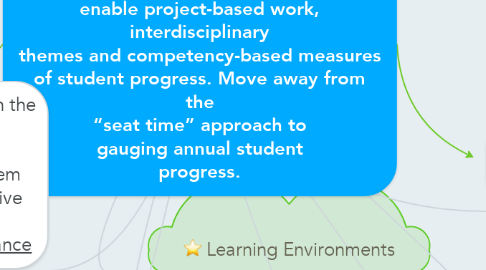Move toward flexible units of time that enable project-based work, interdisciplinary themes and competency-based measures of student progress. Move away from the “seat time” approach to gauging annual student progress.
作者:Amy Hempen

1. Learning Environments
2. Promising Practices
3. -The Chugach School District in Alaska has a waiver from the Alaska Department of Education to use a performance-based system in ten content areas in place of the traditional Carnegie Units. http://www.chugachschools.com/ -New Hampshire eliminated the Carnegie unit requirement; they will instead assess student achievements through demonstrations of subject matter mastery and application. -Rhode Island now uses the term “Carnegie Unit” to refer to courses that are evaluated on competence measures rather than seat time. -In both Rhode Island and New Hampshire, the emphasis is on real-world learning and demonstration of mastery.
4. The High School in the Community, Academy for Law and Social Justice runs on Mastery Based Learning. Students will be directly responsible for their own learning and demonstrate mastery of content and skills before advancing in a course or to the next course. Each student has the opportunity to advance at the pace that is right for him or her. http://www.highschoolinthecommunity.org/mastery-based-learning/
4.1. •Self-direct own learning using outlines and mastery assessments to proceed at a personally challenging but effective pace through course content
4.2. •Learn through multiple pathways: traditional classroom, online courses/resources, extra time in the afternoon, and out of school experiences
4.3. •Build on prior knowledge to develop a comprehensive understanding of new content
5. This site explains the merits of using project based learning in the classroom. PBL Helps Students Develop Skills for Living in a Knowledge-Based, Highly Technological Society. The old-school model of passively learning facts and reciting them out of context is no longer sufficient to prepare students to survive in today's world. http://www.edutopia.org/project-based-learning-guide-importance
5.1. Personal and social responsibility
5.2. Planning, critical thinking, reasoning, and creativity
5.3. Knowing how and when to use technology and choosing the most appropriate tool for the task.
6. This is a good short video introducing the concepts of competency based education and its benefits. https://www.youtube.com/watch?v=RckLD9A0pqc
6.1. Testimonials from different types of educators.
7. A project is meaningful if it fulfills two criteria. First, students must perceive the work as personally meaningful, as a task that matters and that they want to do well. Second, a meaningful project fulfills an educational purpose. Well-designed and well-implemented project-based learning is meaningful in both ways. http://www.ascd.org/ASCD/images/multifiles/publications/elmast.gif
7.1. When a student understands the purpose/reason for the assignment they put more effort into doing well.
8. This website does a great job of explaining what a flipped classroom is, why it works, and the outcome of switching to the flipped classroom method. http://knewton.marketing.s3.amazonaws.com/images/infographics/flipped-classroom.jpg
8.1. Students receive instant feedback
8.2. Students don't get as frustrated
8.3. Teachers revisit concepts students don't understand.
8.4. Teachers support students in class.
8.5. More class time is spent doing practical, hands on learning vs. in seat lecture learning.


